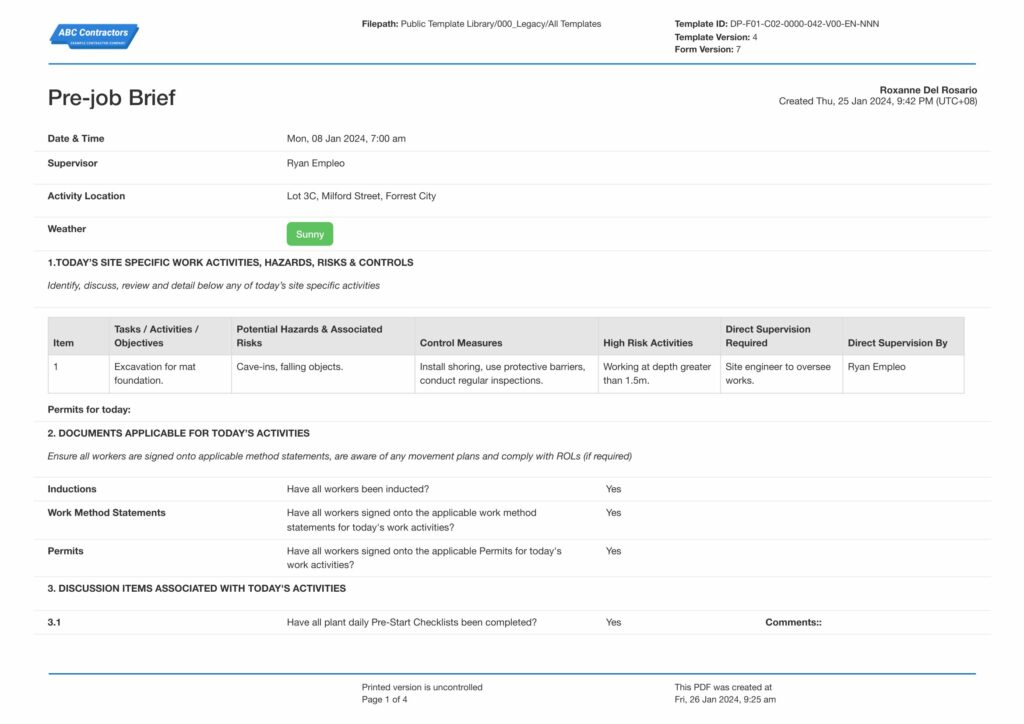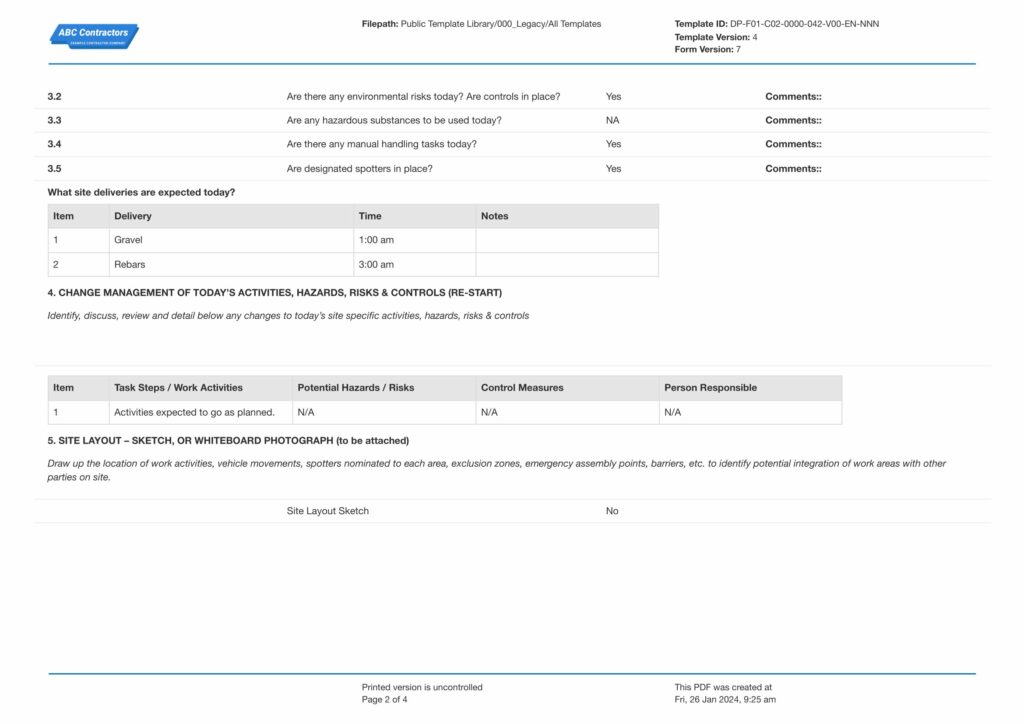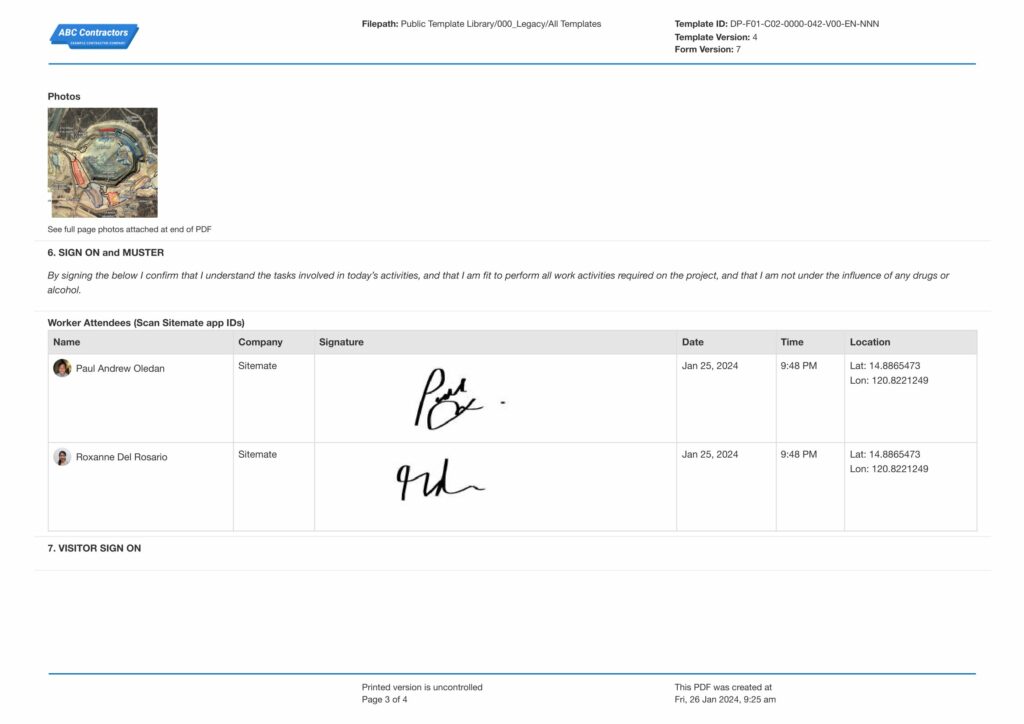Dashpivot Article – OSHA Pre Job Brief Requirements
OSHA Pre Job Brief Requirements
In this article, we cover the relevance of the pre-job brief in the heavy industries, the differences between pre job briefs and toolbox talks, and OSHA pre job brief requirements for safety compliance.

What is a Pre-Job brief?
The fact that practically every action carried out in a variety of industries is fraught with dangers and risks is a well-established reality. Be it in construction, production, power plants, or mining, hazards and risks are always present in these work environments. But of course, humans are ingenious in finding ways to eliminate and mitigate these hazards and risks. We have made measures for almost every specific hazard found in these work environments. One of the best measures we have come up with is the pre-job brief.
Just as its name suggests, a pre-job brief is a briefing that is given on the activity that is about to be carried out. This is typically the first item that is completed prior to the beginning of a task. Specifically, it describes all of the permissions, individual duties, and stages involved in the action in question.
In addition to the processes and duties, a job hazard analysis is carried out for each step. This is done in order to ensure that the proper safety measures are provided before the activity begins. In order to strengthen the application of the safety measures that are intended to control and eliminate the dangers that are associated with the activity, the pre-job brief is designed to raise awareness of the hazards that are associated with the activity.
OSHA's Role on Pre-job Briefs
The Occupational Safety and Health Association is an organisation that is responsible for establishing standards that are recognised all over the world in order to create a safe and healthy working environment for both men and women who are employed. OSHA has created a number of requirements, one of which is the requirement to undertake a job hazard analysis and to take necessary actions to address specific dangers. As an outcome of the fact that these two are included in the contents of a pre-job brief, it is vital to incorporate these OSHA standards in order to not only prevent injuries and accidents in the workplace but also to commit to complying with regulations.
Pre-Job Briefs (PJB) V.S. Toolbox Talks (TBT)
Despite the fact that these two safety measures share a common objective, which is to emphasise the importance of safety in the workplace, their scopes and purposes are completely unlike. In order to have a better understanding of these distinctions, we will be discussing the distinction between a toolbox talk and a pre-job brief at this stage.
Purpose
When it comes to pre-job briefings, the primary purpose is to explain the particulars of the specific task that will take place on the day. The work methods, job hazard assessments, and individual duties assigned to this activity are the primary emphasis of this section. Its purpose is to ensure that all of the workers who are allocated to this activity have a shared comprehension of all of the particulars that pertain to the activity. The themes that are covered in a toolbox talk, on the other hand, are more general in nature, and the discussion does not have to be centred on the activity that takes place on that particular day. It is possible for it to cover a wide range of safety subjects, which might serve as a useful reminder or enhance safety habits in the workplace.
Who conducts it?
Pre-job briefs are to be conducted by supervisors, site foremen, or senior workers who are directly involved in the task. A role that holds a leadership position is required when conducting a pre-job brief, as some of the topics that need to be discussed require decision-making, such as the assignment of roles during the activity. The leadership roles also have the authority to determine whether a specific procedure is safe for workers to commence, which is particularly important in high-risk activities where safety is critical. Additionally, these leadership roles are trained to conduct job hazard analysis, as they are responsible for the overall safety of each activity. To have a more in-depth understanding as to who should conduct pre-job briefings, check this out: Who Should Conduct a Pre-Job Briefing?
Toolbox talks, on the other hand, can be conducted by anyone as long as they are relevant to the practice of safety and the promotion of a healthy workplace.
Frequency
Before engaging in any critical activities, it is mandatory to complete pre-job briefs. This is to guarantee that the employees engaged in this activity are fully cognisant of the potential hazards and possess the necessary knowledge to implement effective mitigation strategies. This will also ensure that all participants have a clear understanding of their responsibilities in the activity, thereby preventing confusion and fostering cooperation. Nevertheless, it is feasible to assert that pre-job summaries are implemented more frequently in industries that pose a high level of risk, such as mining and construction. Toolbox lectures are more adaptable than pre-job briefs. They may be scheduled and executed at any time. However, it is advised that they be conducted on a more frequent basis in order to preserve a positive safety culture.
Contents
The toolbox talk forms typically include the topics to be discussed, the concerns and issues that were raised during the meeting, and the signatures of the attendees.Pre-job briefings are more thorough and in-depth than toolbox presentations. The forms usually contain the steps and the associated job hazard analysis for each step, the roles assigned to workers, the specific precautions taken for each hazard identified in the JHA, and the workflow processes. This is now made in this way to provide clear instructions for carrying out the actual action and to avoid errors that might cause harm. Take a look at a more detailed example here: Pre-Job Brief Example.

Use this Pre-Job Brief format for free
OSHA Pre-Job Brief Requirements
Although the Occupational Safety and Health Administration (OSHA) does not directly list it as a standard, it does contain fields that are pertinent to OSHA requirements that organisations and businesses should comply to. It is important to include this in your pre-job briefing since it will ensure that the organisation or company is in accordance with the legislation that is necessary in the region. In the following paragraphs, you will get a detailed explanation of the relevant fields that should be included in your pre-job briefing. These fields were already described in the paragraphs that came before this one.
Procedures
This provides a thorough explanation of the tasks that need to be completed. Additionally, it lists every subactivity that is a part of the activity. To make this process conceptually simple to follow, the steps should be numbered. Additionally, it should use an active voice to be extremely explicit and action-oriented (e.g., inspect flanges for leaks). Lastly, safety precautions need to be specified in the procedures in order to eradicate incidents that result in injuries. Working with the activity will be safe and consistent if the procedures are placed in a clear, succinct, and organised manner.
Job Hazard Analysis
It is an investigation of the hazards and risks connected with a job that focuses on detecting and controlling hazards. This type of analysis is known as a Job HazardcAnalysis(JHA). Using the JHA will give a methodology for analysing the work activities, which will identify the tools, resources, and equipment that are required to design work techniques and procedures for the purpose of completing the job. Within the process, both present and potential risks will be identified, and a risk assessment will be performed. Additionally, strategies to eliminate or defend against the hazard will be identified.
Clear Roles
In order to progress in a manner that is both successful and efficient in the performance of an activity, the roles need to be well defined. The staff who are in charge of leading the group must first determine who is accountable for each stage of the activity before they can move forward with this. It is important for them to make their decision based on the job description, experience, and competency. By doing so, competent individuals will be better aware of the dangers and safety measures, which will result in a reduction in the likelihood of accidents occurring. This will guarantee that each activity is accomplished with quality.
Documentation
The recording of your pre-job briefings may be of great use. Safe work practices, for the purpose of providing organisations and companies with evidence of one of the safety measures that are necessary to comply with safety requirements, which are frequently discovered by regulatory agencies during audits, include pre-job briefings as one of their components. This will not only serve as proof for regulatory requirements, but it will also function as a record that makes it possible to better future planning activities. As a result of this, the processes and procedures will be enhanced in terms of both their safety and their efficiency.
A Smart Approach in Making your Pre-Job Briefs
As can be seen from the requirements, a significant amount of work is required in order to develop a pre-job brief form that is both effective and compliant. Being able to do all of these tasks manually is a tedious procedure, particularly in industries such as mining and construction, where crucial tasks are performed on a nearly daily basis. The process of constantly reformatting your forms, from the processes to the documentation, takes a significant amount of time for a meeting that can only run for approximately twenty minutes. Imagine having to do this nearly every day. Certainly, it will consume a significant amount of your time, giving you less time to devote to other, more essential things.
Fortunately, there is now a smart way to streamline the processes around your pre-job briefs. With the Dashpivot pre-job brief app, you can improve teamwork and safety by giving clear, easily available, job-specific instructions. Having digital forms, you can utilise the standardised pre-job brief and either fill it up with your information or use the drag-and-drop form builder to modify it to suit your project's requirements. This ultimately removes the hassle of constantly reformatting your forms and speeds up the process of making your forms.
With the Dashpivot pre-job brief app, you can make sure your pre-job briefings are well recorded, using images and videos to emphasise crucial details about the tasks at hand or any risks. Take pictures straight from the pre-job briefing app, which includes smart labelling, geotagging, markup, and automated timestamps for your team to follow. This will ensure your compliance with safety regulatory standards for your records is highly detailed and specific.
All these and more when using the Dashpivot pre-job brief app. To learn more, explore more here at Pre-Job Brief app.
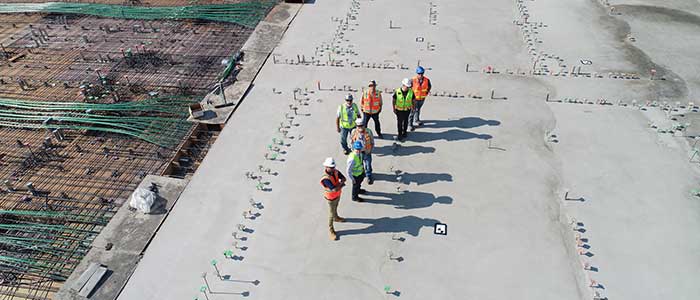
Safety Toolbox Talk template
This toolbox talk template is quick and easy to complete and signoff on site, and keeps all of your toolbox talks neatly organised and professional.

Job Hazard Analysis template
Easily complete a JHA on any device, and then keep all of your job hazard analyses neatly organised and searchable.
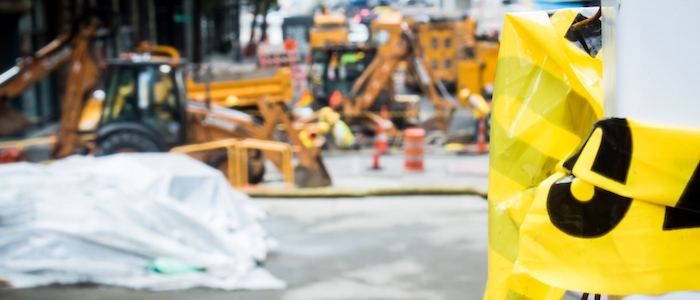
OSHA Form 300 & 300A template
Maintain your log of injuries and illnesses and your 300a summary with this free template.
